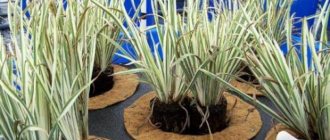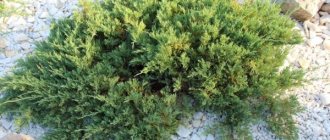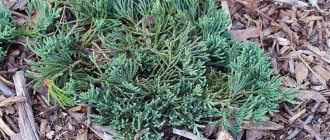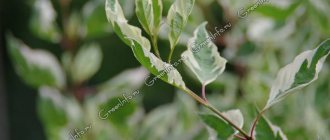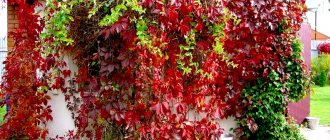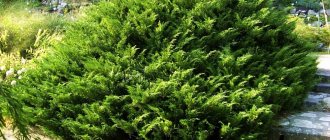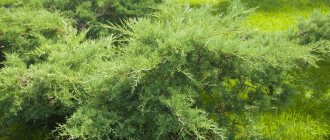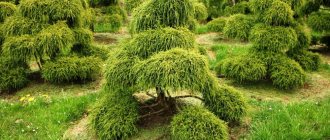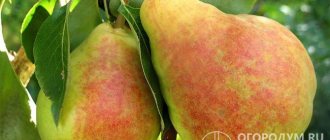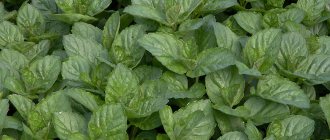Blue juniper is a type of coniferous shrub that differs in color. Juniper belongs to the Cypress family. Plants are common in the countries of the Northern Hemisphere. Some species are adapted to grow in the polar zone, while others have chosen the mountain tropics.
Coniferous crops can grow as a single or multi-stemmed tree, with vertical raised branches or with shoots creeping along the ground. Evergreen shrubs are distinguished by a whole palette of colors. The needles are green, light green, variegated, gray, yellow and blue.
Variety of blue juniper species
Juniper with a blue tint looks noble and majestic. Gardeners and landscape designers prefer shrubs with silvery-bluish needles. Features of junipers with blue berries:
- attractive appearance;
- retain color regardless of the season of the year;
- the possibility of using for landscaping parks, rock gardens, rock gardens;
- they are planted on the banks of artificial reservoirs, slopes, borders, and lawns;
- appropriately complement and fit perfectly into landscape compositions.
Blue junipers, according to their external characteristics, are divided into tall and short, ground-blooded and erect, with a spreading or compact crown.
Soil selection
Juniper Blue Carpet
Juniper Blue is characterized by frost resistance and drought resistance.
That is why its landing can be carried out even in the north of Russia. Before planting a plant, you need to be as careful as possible in choosing the soil. Juniper will not grow well on waterlogged and saline soil. To avoid looseness and fading of the plant, for planting it it is necessary to choose areas that are characterized by very good lighting. With the correct selection of soil, you can ensure not only full growth of the plant, but also the original blue-green color of the soil.
Varieties of blue juniper in landscape design
Coniferous shrubs advantageously decorate the garden, summer cottage, and park alleys. Create a calm, elegant landscape. It is better to imagine vertical blue junipers in the form of a hedge, which will allow you to camouflage the building and isolate yourself from neighbors.
Important! Also, large bushes are good for single planting. They act as the center of the landscape composition.
To create a dense carpet with a clear structure, creeping varieties of blue junipers are planted in the areas. This is a unique alternative to a green lawn, but requires more attention to care. Horizontal plants combine favorably with phlox, carnations, hydrangea, lilac, and cinquefoil. In general, blue junipers look impressive in photos of landscapes and plots. They can add color to a winter garden.
Peculiarities
Most varieties of low-growing junipers cannot be called unpretentious. They require some care and are quite difficult to take root. However, this coniferous shrub can replace a traditional lawn if you plant creeping varieties of juniper, which will grow exceptionally wide and delight with their appearance all year round. In addition, the cleansing properties of juniper are widely known. The shrub very effectively purifies the air around itself and releases special substances - phytoncides, which can kill microbes in the surrounding space.
The aroma of this plant helps relieve tension, improves mood, strengthens the immune system, and fights colds.
Blue juniper varieties
Blue junipers have bright blue, beautiful needle color. In the garden, ground-blooded plants are often planted under tall bushes. They set off the green color of other coniferous or deciduous shrubs. For vertical accents, choose rocky species with a columnar or pyramidal crown shape.
Vertical varieties of blue juniper
As a rule, these shrubs have a pyramidal shape. They are native to North America. The height can reach 10 m. Coniferous shrubs are similar in appearance to cypress. The branches are tightly pressed to the base. Vertical juniper will look interesting in any landscape composition. In demand in regions with hot climates.
Juniperus rocky Skyrocket
In 1957, the variety was developed by Dutch breeders. An elegant tall shrub with green-blue needles. The structure is scaly and dense. Needle-like tips are noticeable on young shoots. The height of the bush is 6-8 m. The width of the crown is 1 m. It develops well in loamy soils. Water stagnation is unacceptable. The variety is frost-resistant, drought- and wind-resistant. Does not tolerate heavy snowfalls. Suitable for hedges and decoration of front entrances.
Blue Arrow
This is an improved variety of the previous shrub. The crown is dense, the color is bright. Columnar shape. Height 5 m, width 0.7 m. Shoots with scaly needles are pressed to the trunk. The branches grow almost from the very bottom. The color is deep blue. The plant withstands frosts and is easy to care for. Grows well in well-drained, sunny areas. Easily amenable to spiral cutting. It combines well with other crops and takes up little space on the site.
Blueheaven
Rocky species with a dense conical crown shape. The color of the pine needles is sky blue, which does not fade all year round. Height 3-5 m, width – 1.5 m. Shoots are raised, cylindrical. The needles are scaly. This type of blue juniper is highly frost-resistant. Soil composition does not matter. Rapid growth is observed in fertile, well-drained soils. Prefers a sunny place. In partial shade the crown becomes looser.
Springbank
The vertical variety was developed at the end of the twentieth century. Grows up to 2 m in height. The crown shape is narrow-pointed. The shoots are flexible, deviated from each other. The ends are threadlike. The needles are scaly, bright blue. The shrub grows quickly. Easily tolerates periods of drought and severe cold. Propagated by cuttings. Suitable for group plantings.
Wichitablue
The variety appeared in 1976 in the USA. An upright variety with intensely colored blue needles. The crown is broadly pin-shaped. The shoots fit tightly and are directed upwards. The height of the bush is 4 m. Planting in illuminated, flat areas is preferable. The proximity of groundwater is unacceptable.
Blue varieties of creeping juniper
There are about 60 types of horizontal plants. They all differ in the shape of their needles, long creeping shoots, and creeping branches. They grow slowly. Does not tolerate high humidity well. Blue low junipers are used to decorate gardens, terraces, and garden plots.
Wiltoni
The American species of blue juniper became famous in 1914. The creeping shrub has a height of 20 cm and a diameter of 2 m. The branches grow along the ground, forming a continuous cover. The shoots are intertwined in the shape of a star. The shoots are dense, obliquely directed. Over time, they layer on top of each other. The gray-blue needles fit tightly to the branches. Needle-shaped.
Blue Forest
Compact horizontal variety with short skeletal shoots. Side shoots grow vertically. The needles are protruding, needle-shaped, thick. Color – deep blue. Grows up to 50 cm in height. When formed correctly, it creates a graceful appearance.
Bar Harbor
A creeping variety of blue juniper with dense needles. Created in 1930 by American breeders. Branches and side shoots spread widely to the sides. Sometimes the plant is used as a ground crop. The height of the bush is 30 cm. The needles are small, needle-shaped, loosely pressed to the branches. After the first frost, the blue tint changes to purple.
Blue Chip
The variety was cultivated in 1945 in Denmark. Skeletal branches are rare. The edges of the shoots are directed upward almost vertically, resembling a star in shape. Low juniper form with a raised middle. The needles are mostly needle-shaped, but scaly ones are also found. The shade is grey-blue. There are thorns. Blue ground-blooded juniper does not tolerate excess moisture, so it is planted in a hole with a mandatory layer of drainage.
Ice Blue
A low shrub with a height of only 15 cm. It is distinguished by significant annual growth. The crown grows up to 2.5 m in diameter. The branches are creeping. The shoots are thick, long, and form a continuous carpet. The needles are dense, silver-blue in color. In winter it turns purple. It is recommended to plant the plant in sandy loam soil, or add baking powder to clay soils. Blue juniper is adapted to arid and cold growing regions.
Blue Moon
In adulthood, this creeping bush reaches 30 cm. The needles are bluish-gray. The branches lie on the surface of the ground and can take root on their own. The shoots are thin and long. In the summer months they have a bluish tint, turning brown in winter. Blue juniper forms dense spherical webs.
Glauka
A creeping shrub with tightly pressed branches. Lush shoots form a fluffy pillow. Needles of needle type. The color varies from blue to steel. With the arrival of cold weather, the color remains unchanged. Prefers fertile soils.
Winter Blue
Beautiful ground-blooded blue juniper. Grows in any soil. Decorative qualities are not lost in well-lit, sunny areas. The color of the needles is silver in summer, and becomes bright blue in winter.
Botanical description
Among the representatives of the Cypress family, the evergreen juniper stands out for its needles, which can be a tall tree with a branched trunk, or maybe a three-meter bush. Blue juniper differs from its relatives in the unusual color of its needles. This shrub is resistant to unfavorable climatic conditions, which explains its wide distribution - from the polar zone to the mountain tropics.
Did you know? Juniper can live up to 600 years, and first appeared on our planet about 50 million years ago.
Carrying out a botanical description, the following can be noted:
| Leaves | shortened, needle-shaped, completely adjacent to the shoots, initially needle-like, and over time scale-like |
| Kidneys | without scales |
| Cones | scaly, round shaped cones containing 10 seeds |
Planting and caring for blue juniper
Blue junipers do not tolerate transplantation well, due to the existing highly branched root system. Therefore, it is important to immediately choose a permanent place for the evergreen shrub.
Important! Plants are able to grow in partial shade.
Shrubs with blue needles are undemanding in terms of soil composition. However, it is better to plant them in sunny areas with well-drained soil. A moderate lack of lighting reduces the decorative properties of the shrub. The complete absence of sunlight leads to yellowing of the needles and loss of crown density.
Rules for planting juniper Blue
It is advisable to purchase blue juniper seedlings with a closed root system, in plastic containers. Before purchasing, visually inspect the plant for damage, signs of rot or other diseases.
The shrub grows quickly in sandy, neutral or slightly acidic soils. Clayey, heavy soils are not suitable for planting Blue juniper.
- 2-3 days before the intended planting, dig holes 60-70 cm deep.
- A 20 cm drainage layer of broken brick or crushed stone is placed in the prepared pit.
- They are filled to a depth of 20 cm with a nutrient mixture of turf soil, peat, sand, combining the components in equal proportions. This layer will contribute to better penetration and development of roots.
- Immediately before the procedure, pour a bag of vermicompost diluted with perlite and pine needles into the recess. The substances will add lightness to the substrate.
- Place a blue juniper seedling in the center of the recess. The root collar should not be buried.
- The soil is not compacted; the top is moistened generously with warm water.
- Mulch the surrounding area with sawdust, hay or straw. Layer thickness 3-5 cm.
Caring for juniper with blue needles
Caring for blue juniper is no more difficult than caring for other conifers. The plant reacts sharply to excess moisture in the soil. In hot summers, one water procedure per month is enough. On hot days, you can additionally spray the bush with water from a spray bottle.
Attention! No watering is needed in autumn and winter.
Fertilizers are applied in the spring. They mainly use nitroammophoska - 20 g per square meter. m or other minerals, according to the manufacturer's instructions.
Junipers do not like loosening the soil very much, especially blue ones. Their roots are close enough to the surface of the earth that a careless movement can damage their integrity. Therefore, tree trunk circles are loosened no deeper than 5 cm. Or this procedure is not carried out at all, but is replaced by mulching.
Curly varieties or hedge bushes require regular pruning. Their crown is formed several times a year. Low creeping juniper with blue needles does not require additional pruning other than sanitary pruning. It is performed in early spring before the onset of sap flow. Remove dry, damaged shoots. Trim frozen ends on the bush.
Reproduction methods
To develop new varieties, breeders use seed propagation. However, it is beyond the power of an ordinary gardener, because... is the most complex, requires certain knowledge and skills, time and effort, but does not guarantee the expected result.
Important! The juniper is planned to be transshipped in the fall, and in the summer it is gradually dug up to reduce the diameter of the root system and deepen it.
Simpler methods include reproduction:
- layering;
- vaccination;
- cuttings.
Layering can be used to propagate plants whose branches are located close to the ground and can be bent down without damaging them. Horizontal varieties are ideal for this method.
The sequence of actions is as follows:
- Choose the strongest and healthiest branch, which is 3–5 years old.
- Small cuts are made on it every 10–15 cm - roots will form here.
- The branch must be placed in a small trench where peat and sand have been poured.
- Secure the branch by covering it with sand and watering it.
In summer, the amount of sand and humidity should be controlled. The young rooted plant remains to overwinter, and in the spring it is separated from the “mother” bush and transplanted to a permanent place.
Did you know? The specific smell of Blue Danube juniper can repel moths.
Reproduction by grafting allows you to combine the best qualities of two varieties in one plant. The procedure must be carried out before “awakening”, i.e. until sap flow resumes in the spring. Shoots 1-2 years old and about 5 cm long (scion) are taken from the upper tier. And the rootstock becomes a bush whose buds have already swelled.
Next steps:
- Process the instruments.
- Cut off the tops of branches on the scion and rootstock.
- Align the cuts and press tightly, securing with insulating tape.
- Apply resin or garden varnish.
The plant requires special care. “Gentle” external conditions are recommended for him and intense sunlight is contraindicated. The greenhouse parameters are ideal. When the buds bloom, which will mean the success of the procedure, you need to loosen the tape. The bandage should be completely removed only after a year.
We advise you to find out when is the best time to replant juniper to a new location.
Propagation by cuttings does not require much time or physical effort. It is recommended to harvest them from strong bushes, whose age is no more than 15 years. These can be main or side branches from the middle or top of the crown. It is necessary to prepare a special substrate of coarse sand and peat, which should be leveled, compacted and moistened.
The cuttings are deepened by 5–7 cm with an interval of up to 6 cm. If planting in several rows, you need to maintain 6–8 cm between them. Water with a solution of potassium permanganate or fungicides. Harvesting is done on the eve of spring or at the very beginning of autumn so that rooting is effective. It is advisable to place the planting in a greenhouse for several months, and plant it in the spring, when not only the air, but also the soil has warmed up.
Important! Seedlings obtained by grafting grow more slowly than others.
Preparing blue juniper for winter
For the first two years, young shrubs are covered. Use spruce branches, agrofibre or burlap. In spring, a plastic box or cardboard box is placed on the seedling to protect the plant from sunburn. Horizontal varieties are not afraid of snow; on the contrary, it serves as insulation. For vertical varieties of juniper, snowfall is dangerous. To protect the branches from breakage and precipitation pressure, they are tied with rope.
How to grow?
Care and cultivation at home requires the fulfillment of special conditions.
- Priming. Low-growing junipers are demanding on soil quality. Their root system needs loose and nutritious soil, otherwise it will be difficult for the plant to take root. You can prepare a mixture of peat, soil and sand yourself, or you can buy a special mixture in the store.
- Drainage system. Due to the nature of the root system, moisture should also not be allowed to stagnate, as this can lead to the death of the bush. Drainage can be made independently from crushed stone or expanded clay.
- Location. Dwarf junipers prefer warmth and light. This must be taken into account when planting.
- Watering. The plant does not tolerate excess moisture. Therefore, generous and regular watering will negatively affect it. But he is not afraid of dry weather.
If a transplant is required
- Young seedlings can be replanted by carefully digging them out with a large lump of earth. Adult plants tolerate transplantation extremely poorly, but if such a need arises, do this:
- Young seedlings can be replanted by carefully digging them out with a large lump of earth. Adult plants tolerate transplantation extremely poorly, but if such a need arises, do this:
- Plan replanting for the fall.
- In the summer, start digging around an adult plant: cut the turf around the adult juniper with a shovel to the height of a bayonet in a circle. In this way, small roots will be cut, but the juniper will not die; it will use deeper roots for nutrition.
- Over the summer, the replacement root system will grow and take the shape of a trimmed circle; the plant will tolerate replanting well.
Disembarkation
Juniper Blue Danube
The tree can be planted alone or in a group.
If juniper is planted in groups, then a distance of at least half a meter must be maintained between them. If possible, it would be best to leave two meters between the trees. An adult plant should be planted to a depth of more than 0.7 meters. Sand or broken bricks are placed at the bottom of the pit. When planting the plant, the root collar should remain at ground level.
Please note: to plant a plant, you need to dig a hole the size of which is twice the diameter of the earthen ball.
If groundwater is located close, then drainage must be done. For this purpose, crushed stone is used, which is poured into the pit in a layer of 10 centimeters.
Spreading
In the wild, Blue Arrow juniper prefers rocky soil surfaces. In its native North America, it can be found growing wild in this area.
In growing Blue Arrow, gardeners have found that it is very tolerant of changing climate conditions and tolerates a wide range of soils. Therefore, it can be grown almost anywhere, from the tropics to the Arctic Circle.
In our country, only the regions of the far north are not suitable for cultivation. But even in this case, you can safely buy this tree and grow it at home on the terrace.
